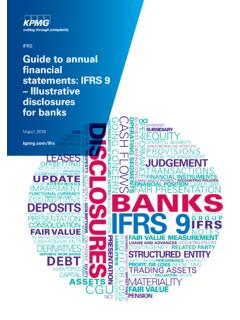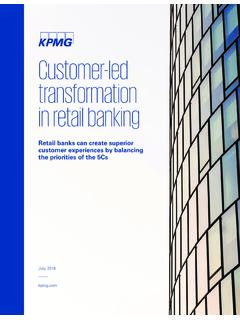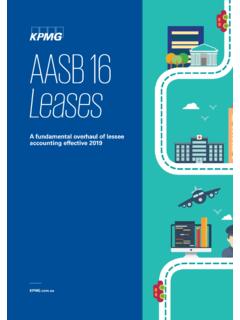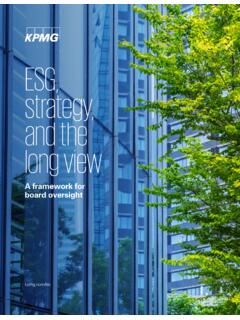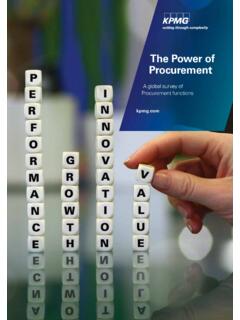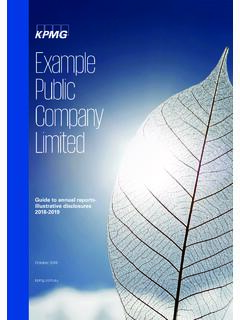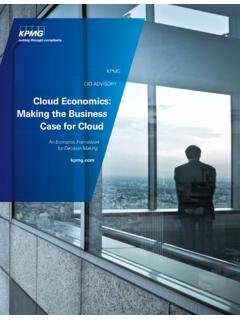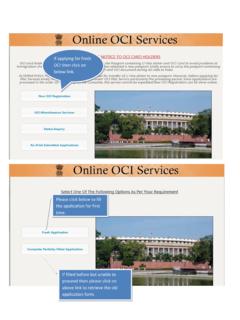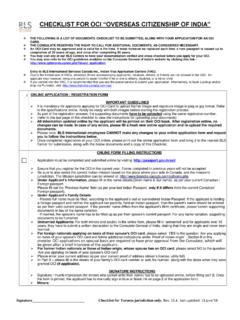Transcription of IFRS compared to US GAAP - assets.kpmg
1 IFRS compared to US GAAP. December 2017. 2 IFRS compared to US GAAP. Contents A changing focus 1 Related party disclosures 375. Investment entity consolidation exception About this publication 2 [Investment company consolidation exception] 381. Non-monetary transactions 386. 1 Background 4. Accompanying financial and other information 390. Introduction 4. Interim financial reporting 393. The Conceptual Framework 10. Disclosure of interests in other entities 400. 2 General issues 14 Extractive activities 404. Service concession arrangements 412. US. Basis of preparation of financial statements 14. Form and components of financial statements 18 Common control transactions and Newco Statement of cash flows 23 formations 418. Fair value measurement 32. 6 [Not used]. Consolidation 42. Business combinations 59 7 Financial instruments 423. Foreign currency translation 77 Scope and definitions 423.
2 Accounting policies, errors and estimates 88 Derivatives and embedded derivatives 429. Events after the reporting date 94 Equity and financial liabilities 434. Hyperinflation 99 Classification of financial assets and financial liabilities 447. 3 Statement of financial position 102. Recognition and derecognition 454. General 102. Measurement and gains and losses 462. Property, plant and equipment 107. Hedge accounting 476. Intangible assets and goodwill 116. Presentation and disclosure 491. Investment property 129. Associates and the equity method 8 Insurance contracts 499. [Equity-method investees] 138 Insurance contracts 499. Joint arrangements [Investments in joint ventures] 154 Effective dates: US GAAP 508. [Not used]. Keeping in touch 510. Inventories 158. Biological assets 165 Acknowledgements 512. Impairment of non-financial assets 168. [Not used]. Provisions, contingent assets and liabilities [Recognised contingencies and other provisions'] 181.
3 Income taxes 197. 4 Specific items of profit or loss and OCI 217. General 217. IFRS. Revenue 222. Revenue from contracts with customers 244. Government grants 258. Employee benefits 260. Share-based payments 280. Borrowing costs [Financial income and expense] 308. 5 Special topics 312. Leases 312. Leases 328. Operating segments 347. Earnings per share 353. Non-current assets held for sale and discontinued operations 365. 2017 KPMG LLP, a Delaware limited liability partnership and the member firm of the KPMG network of independent member firms affiliated with KPMG International Cooperative, a Swiss entity. All rights reserved. 2017 KPMG IFRG Limited, a UK company, limited by guarantee. All rights reserved. A changing focus Both the FASB and the IASB believe that the era of sweeping accounting change has come to an end, for now, and both are committed to helping companies implement the new major standards.
4 Although they will continue to make incremental changes to their respective GAAPs, convergence is not a continuing priority, and there are no formal joint FASB-IASB projects currently planned. Instead, there's a change in focus to enhancing transparency through better communication between companies and the users of their financial statements, such as investors and analysts. This is clearly visible in the IASB's Better communication in financial reporting'. initiative, which focuses on principles for more transparent and to-the-point disclosures, a balanced use of non-GAAP measures and a fresh look at performance reporting overall. The IASB also wants to expand its reach beyond the four corners of the financial statements by working to promote a stronger link between financial statements and financial disclosures outside those statements as part of a new project on Wider corporate reporting'.
5 Against this backdrop, we are pleased to publish this 2017 edition of our comparison of IFRS and US GAAP, which highlights the key differences between the two frameworks. If you're a preparer, it may help you to identify areas to emphasise in the financial statements; if you're a user, it may help you spot areas to focus on in your dialogue with preparers. Reinhard Dotzlaw and Paul Munter and Prabhakar Kalavacherla Julie Santoro KPMG International Department of Professional Practice Standards Group KPMG in the US. 2017 KPMG LLP, a Delaware limited liability partnership and the member firm of the KPMG network of independent member firms affiliated with KPMG International Cooperative, a Swiss entity. All rights reserved. 2017 KPMG IFRG Limited, a UK company, limited by guarantee. All rights reserved. 2 IFRS compared to US GAAP. Purpose About this publication The purpose of this publication is to help you understand the significant differences between IFRS and US GAAP.
6 Although it does not discuss every possible difference, this publication provides a summary of those differences that we have encountered most frequently, resulting from either a difference in emphasis, specific application guidance or practice. The focus of this publication is primarily on recognition, measurement and presentation. However, areas that are disclosure-based, such as segment reporting and the assessment of going concern, are also covered. Scope This publication highlights the main differences of principle, emphasis or application between IFRS and US GAAP. It does not address the requirements of the IFRS for Small and Medium-sized Entities or the initiative of the FASB. and the Private Company Council in determining accounting alternatives for private companies under US GAAP. It also does not address the requirements of IAS 26 Accounting and Reporting by Retirement Benefit Plans or the equivalent US GAAP.
7 Otherwise, this publication addresses the types of businesses and activities that IFRS addresses. So, for example, biological assets are included, but accounting by not-for-profit entities is not. In addition, this publication focuses on consolidated financial statements separate ( unconsolidated) financial statements are not addressed. Lastly, the requirements of IFRS are discussed on the basis that the entity has adopted IFRS already and therefore the following are excluded from this publication: IFRS 1 First-time Adoption of IFRS and IFRS 14 Regulatory Deferral Accounts. The special transition requirements that apply in the period in which an entity changes its GAAP to IFRS, including the implications for an entity in the scope of IFRS 14, are discussed in our publication Insights into IFRS, KPMG's practical guide to International Financial Reporting Standards find out more at Organisation of the text This publication is largely organised consistently with Insights into IFRS.
8 It summarises the requirements of IFRS in the left-hand column. In the right-hand column, it compares US GAAP to IFRS, highlighting similarities and differences. At the start of each chapter is a brief summary of the key requirements of IFRS, contrasted with the parallel requirements of US GAAP. The summary provides a quick overview for easy reference, but is not detailed enough to allow a full understanding of the significant differences. Although we have highlighted what we regard as significant differences, we recognise that the significance of any difference will vary by entity. Some differences that appear major may not be relevant to your business; by contrast, a seemingly minor difference may cause you significant additional work. One way to obtain an appreciation of the differences that may affect your business is to browse through the summary at the start of each chapter. In certain cases, this publication includes the specific views that we have developed in the absence of explicit guidance under IFRS or US GAAP.
9 In some cases, we note what we would expect in practice, and in other cases we simply note that practice varies or may vary. Our commentary is referenced to current IFRS literature and the US Accounting Standards Codification (FASB ASC or Codification) as follows. In respect of IFRS, references in square brackets identify any relevant paragraphs of the standards or other literature IAS is paragraph 54. of IAS 1; IAS is paragraph 1 of the IAS 18 illustrative examples. References to IFRS Interpretations Committee decisions, addressed in its 2017 KPMG LLP, a Delaware limited liability partnership and the member firm of the KPMG network of independent member firms affiliated with KPMG International Cooperative, a Swiss entity. All rights reserved. 2017 KPMG IFRG Limited, a UK company, limited by guarantee. All rights reserved. About this publication 3. publication IFRIC Update, are also indicated IU 01-13 is IFRIC Update January 2013.
10 In respect of US GAAP, references in square brackets identify any relevant paragraphs of the Codification 220-10-45-3 is paragraph 45-3 of ASC. Subtopic 220-10; TPA is paragraph 15 of TPA 1300. References to SEC Regulations S-X or S-K are also indicated. The references at the start of each chapter indicate the main literature related to that topic, based on currently effective requirements. Effective dates Generally, the standards and interpretations included in this publication are those that are mandatory for an annual reporting period beginning on 1 January 2017. ignoring standards and interpretations that might be adopted before their effective dates. New standards and interpretations published by 1 December 2017, but not effective for an annual reporting period beginning on 1 January 2017, are briefly mentioned at the end of the relevant chapter (as forthcoming requirements) to the extent that we believe them significant to an understanding of the differences between IFRS and US GAAP.
